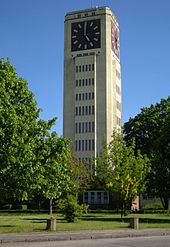Felix Ascher (architect)

Felix Ascher ( March 27, 1883 in Hamburg - October 6, 1952 in London ; full name: Felix Daniel Ascher ) was a German architect .
Family and life
Felix Ascher was the son of Gustav Joachim Ascher and Emilie Ascher (born Blumenfeld, August 20, 1858 in Burgsteinfurt / Westphalia - July 19, 1942 in Hamburg due to suicide). He had two siblings Alice (August 16, 1880 in Hamburg - December 6, 1941 deported to Riga) and Richard (born October 18, 1888). The family lived in Hamburg's Sierichstrasse 18. He grew up in Hamburg and graduated from Wilhelm-Gymnasium in 1902 . He then studied architecture at the Technical University of Charlottenburg and at the Technical University of Munich . He completed his studies with a degree in engineering and initially worked as a salaried architect, including for a long time in the office of the renowned Berlin architect Alfred Messel . From 1913 he was self-employed in Hamburg.
Ascher married Anna Karoline von Gizycki (1887–1949), c. Hinrichsen, a daughter of Adolf von Gizycki . No children came from this connection. However, his wife brought three children with her.
After 1933, as a Jew, Felix Ascher was discriminated against, ostracized and persecuted in accordance with the National Socialist Nuremberg Laws . Ascher emigrated to London in 1938. In London, however, he had great difficulties establishing himself in his profession.
From there he worked in 1951 on the design of the memorial at the Ohlsdorf Jewish cemetery . Ascher died in London on October 6, 1952 and he was buried in the Ohlsdorf cemetery in Hamburg (grave complex P26-51 / 60 at that time; today: P26-51 / 55 Fam. Hanebuth).
Stolpersteine in front of Braamkamp 36 in Hamburg-Winterhude are reminiscent of his mother Emilie, his sister Alice and their partner Margot Doctor .
Buildings and designs
Ascher was the architect of the large extension of the Singer sewing machine factory in Wittenberge, which was carried out between 1928 and 1929 ; this plan includes the preserved clock tower with the largest free-standing clock on the European mainland. The architectural forms of the yellow plastered tower reveal an influence of Expressionism and above all the New Building .
Together with the architect Robert Friedmann , he designed the synagogue of the liberal Jewish temple association on Oberstrasse in Hamburg- Harvestehude , which was inaugurated in 1931 , a monumental and at the same time functional and simple building with facades in light shell limestone.
literature
- Ascher, Felix . In: Hans Vollmer (Hrsg.): General Lexicon of Fine Artists of the XX. Century. tape 1 : A-D . EA Seemann, Leipzig 1953, p. 71-72 .
- Ascher, Felix . In: General Artist Lexicon . The visual artists of all times and peoples (AKL). Volume 5, Saur, Munich a. a. 1992, ISBN 3-598-22745-0 , p. 285.
- Myra Warhaftig : German Jewish Architects before and after 1933. The Lexicon. Dietrich Reimer Verlag, Berlin 2005, ISBN 3-496-01326-5 , p. 32.
Web links
Individual evidence
- ↑ https://www.ndr.de/der_ndr/unternehmen/geschichte/Das-neue-Rolf-Liebermann-Studio-Ein-Schmuckstueck-des-NDR,liebermann118.html
- ^ Johann Klarmann : The renewed humiliation. Hamburg's handling of the former Neuengamme concentration camp from 1945 to 1985. (= publications by the Hamburg Working Group for Regional History (HAR) , Volume 33.) Hamburg 2013, ISBN 978-3-643-12131-8 , pp. 65 f.
- ^ Stumbling blocks in Hamburg: Alice Ascher (* 1880) Braamkamp 36 (Hamburg-Nord, Winterhude)
| personal data | |
|---|---|
| SURNAME | Ascher, Felix |
| ALTERNATIVE NAMES | Ascher, Felix Daniel (full name) |
| BRIEF DESCRIPTION | German architect |
| DATE OF BIRTH | March 27, 1883 |
| PLACE OF BIRTH | Hamburg |
| DATE OF DEATH | October 6, 1952 |
| Place of death | London |
